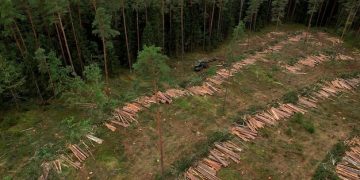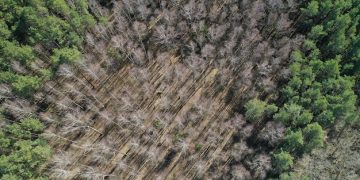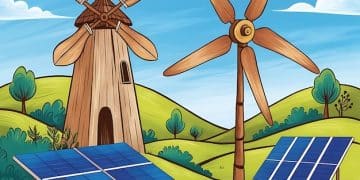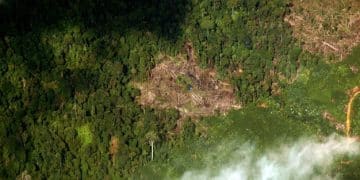Deforestation & Invasive Species: Threat to US Ecosystems
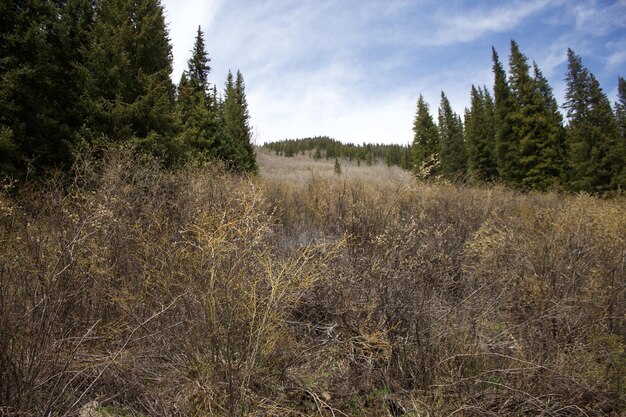
Deforestation and invasive species pose a significant and escalating threat to US ecosystems by disrupting natural habitats, reducing biodiversity, and increasing the risk of wildfires, thereby endangering ecological balance and native species.
The United States has always embraced its abundance of natural resources and diverse ecosystems. However, deforestation and invasive species are creating an environmental crisis throughout the country, and the combination of these two factors is especially dangerous.
Deforestation in the US: Scope and Scale
Deforestation in the United States, while not as severe as in some tropical regions, remains a significant environmental issue. It affects various ecosystems across the nation, from the temperate rainforests of the Pacific Northwest to the hardwood forests of the East Coast.
Main Causes of Deforestation
Deforestation in the U.S. stems from a variety of economic activities, each contributing to the loss of forest cover. Understanding these drivers is crucial for implementing effective conservation strategies.
- Urban Development: As cities and suburbs expand, forests are cleared to make way for new housing, roads, and commercial infrastructure.
- Agriculture: Forests are often converted into farmland for crops or pastureland for livestock. This is particularly prevalent in regions with fertile soil and favorable climates.
- Logging: Timber harvesting, whether for lumber, paper, or fuel, remains a driver of deforestation. While sustainable forestry practices exist, clear-cutting can have devastating impacts on ecosystems.
Regional Impacts of Deforestation
The effects of deforestation vary by region, reflecting differences in forest types, land use practices, and economic activities.
- Pacific Northwest: Extensive logging has led to habitat loss for species like the Northern Spotted Owl and impacted salmon populations due to increased sedimentation in rivers.
- Southeast: Conversion of forests to pine plantations and agricultural land threatens biodiversity and water quality.
- Appalachia: Mountaintop removal mining and logging have caused significant deforestation, impacting watersheds and forest ecosystems.
Deforestation in the US has a wide range of local and far-reaching consequences, changing habitats, polluting waterways and increasing the risk of destructive invasive species.
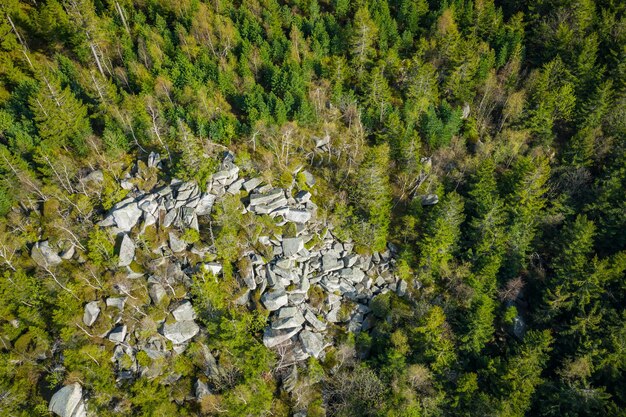
The Rise of Invasive Species in Deforested Areas
Invasive species often thrive in disturbed environments, and deforested areas provide ideal conditions for their establishment and spread. These species can outcompete native plants and animals, further degrading ecosystems.
How Deforestation Facilitates Invasion
Deforestation disrupts the natural balance of ecosystems, creating opportunities for invasive species to gain a foothold.
- Habitat Fragmentation: Deforestation isolates patches of forest, making them more vulnerable to invasion by edge species adapted to disturbed environments.
- Increased Sunlight and Nutrient Availability: Cleared areas receive more sunlight and may experience increased nutrient runoff, favoring the growth of invasive plants.
- Disturbed Soil: Logging and land clearing can disturb the soil, creating conditions suitable for the germination and establishment of invasive plants.
Notable Invasive Species in US Forests
Several invasive species pose significant threats to US forests, altering ecosystem structure and function.
- Kudzu: This fast-growing vine smothers native vegetation, reducing biodiversity and altering forest structure.
- Emerald Ash Borer: This invasive beetle kills ash trees, causing widespread mortality and altering forest composition in affected areas.
- Garlic Mustard: This aggressive herbaceous plant outcompetes native wildflowers and tree seedlings, reducing plant diversity and altering forest regeneration.
These invasive species have significant impacts on US forests, competing with native plants and animals for resources, altering the ecosystem and accelerating deforestation.
Ecological Impacts of Deforestation and Invasive Species
The combined effects of deforestation and invasive species can have far-reaching consequences for ecosystems, impacting biodiversity, water quality, and climate regulation.
Biodiversity Loss
Deforestation and invasive species are major drivers of biodiversity loss, threatening the survival of many native species.
The disruption of habitats due to deforestation and the competitive advantages of invasive species lead to the decline of native plant and animal populations.
Water Quality Degradation
Deforestation can increase soil erosion and sedimentation in waterways, while invasive plants can alter nutrient cycles and water availability.
The consequences include reduced water clarity, increased flooding risk, and harm to aquatic ecosystems. The combined effects of deforestation and invasive species can severely degrade habitats that support aquatic life.
Climate Change Impacts
Deforestation reduces carbon sequestration, while invasive species can alter ecosystem carbon storage capacity.
- Reduced Carbon Sink: Forests act as carbon sinks, absorbing carbon dioxide from the atmosphere. Deforestation diminishes this capacity, contributing to climate change.
- Altered Ecosystem Function: Invasive species can alter carbon and nitrogen cycles, further impacting ecosystem carbon storage potential.
The detrimental impact of deforestation and invasive species leads to a reduction in biodiversity, decline in water quality and effects on climate change.
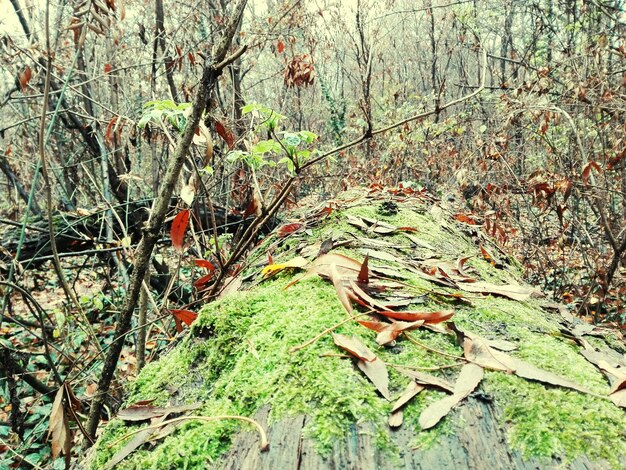
Economic Consequences of Deforestation and Invasive Species
Beyond their ecological impacts, deforestation and invasive species also have significant economic consequences, affecting industries such as forestry, agriculture, and tourism.
Impacts on the Forestry Industry
Deforestation reduces timber supplies, while invasive species can damage or kill commercially valuable trees.
The economic losses can be substantial, affecting timber production, forest product industries, and related employment opportunities. The forestry industry faces the challenge of dealing with both forest loss and the added threat of invasive species.
Agricultural Losses
Invasive species can infest agricultural land, reduce crop yields, and increase pest control costs.
This can lead to economic losses for farmers and increased food prices for consumers. The ability of invasive species to thrive in disturbed environments means that farmlands adjacent to deforested areas are particularly vulnerable.
Tourism and Recreation
Deforestation and invasive species can degrade scenic landscapes and recreational areas, reducing tourism revenue.
The decline in aesthetic and recreational value can impact local economies that depend on tourism. Forests provide spaces for recreation such as hiking, camping, and wildlife viewing, and their degradation affects those who depend on these resources.
Forests are a significant source of economic activity and employment in specific regions and across the country. Deforestation and invasive species have negative economic impact on many businesses and individual livelihoods.
Mitigation and Management Strategies
Addressing the intertwined challenges of deforestation and invasive species requires a multifaceted approach involving sustainable forestry practices, invasive species management, and policy interventions.
Sustainable Forestry Practices
Implementing sustainable forestry practices can reduce deforestation and maintain biodiversity.
Integrated Invasive Species Management
Managing invasive species requires a comprehensive approach that combines prevention, early detection, and rapid response.
- Prevention: Preventing the introduction and spread of invasive species is the most cost-effective management strategy.
- Early Detection and Rapid Response: Detecting and controlling invasive species early can prevent them from becoming widespread.
- Control and Eradication: Various control methods can be used to manage invasive species, including mechanical removal, herbicide application, and biological control.
Policy and Regulatory Interventions
Government policies and regulations play a crucial role in addressing deforestation and invasive species.
- Forest Conservation Policies: Policies that protect forests from deforestation, such as land use regulations and conservation easements, can help maintain forest cover and biodiversity.
- Invasive Species Regulations: Regulations that restrict the import, sale, and transport of invasive species can help prevent their introduction and spread.
- Incentive Programs: Incentive programs that encourage landowners to implement sustainable forestry practices and manage invasive species can enhance conservation efforts.
Utilizing strategic and dynamic approaches can help to maintain biodiversity, create healthy ecosystems and limit climate change related issues.
Community Involvement and Education
Engaging communities and raising awareness about the impacts of deforestation and invasive species are essential for effective conservation efforts.
Community-Based Conservation
Involving local communities in conservation efforts can enhance stewardship and promote sustainable resource management.
This includes supporting community-based forestry initiatives, promoting sustainable agriculture practices, and empowering local residents to participate in invasive species monitoring and control.
Educational Initiatives
Raising public awareness about the threats posed by deforestation and invasive species can encourage responsible behavior and support for conservation policies.
This includes educational programs in schools, outreach campaigns in communities, and online resources that provide information about the impacts of deforestation and invasive species and promote conservation actions.
Community and individual stewardship can create a more sustainable and healthy environment for generations to come.
| Key Point | Brief Description |
|---|---|
| 🌳 Deforestation Scale | US forests face threats from urban growth, agriculture, and logging. |
| 🌱 Invasive Spread | Deforested areas become vulnerable to invasive species like Kudzu. |
| ⚠️ Ecological Impact | Biodiversity decreases, and water sources are highly impacted. |
| 🛡️ Management Strategies | Strategies such as forest policies and local conservation are effective. |
Frequently Asked Questions
▼
Deforestation in the US is primarily caused by urban development, agricultural expansion, and logging operations. These activities lead to the clearing of forests for various economic and infrastructure needs.
▼
Invasive species thrive in deforested areas because these environments offer less competition from native plants. Invasive plants like kudzu can quickly dominate, preventing the regrowth of native forests.
▼
Mitigating deforestation involves promoting sustainable forestry practices, such as selective logging and reforestation. Stronger environmental protection policies and community involvement are also crucial to conservation efforts.
▼
Common invasive species include the Emerald Ash Borer, which kills ash trees, and Garlic Mustard, which outcompetes native plants. These species can significantly alter forest ecosystems and reduce biodiversity.
▼
Deforestation contributes to climate change by reducing the number of trees available to absorb carbon dioxide. When trees are cut down, the stored carbon is released into the atmosphere, increasing greenhouse gas concentrations.
Conclusion
Addressing the dual threats of deforestation and invasive species in US ecosystems requires a concerted effort from policymakers, industries, communities, and individuals. By adopting sustainable practices, supporting conservation initiatives, and raising awareness, we can safeguard the ecological integrity and economic value of US forests for future generations.
